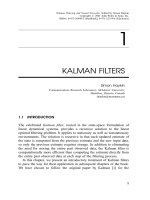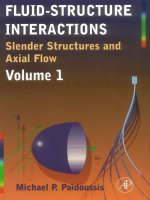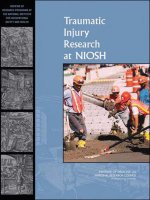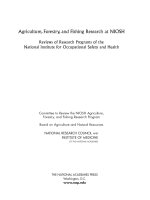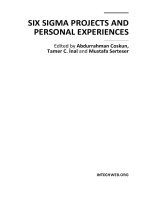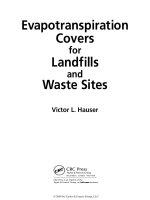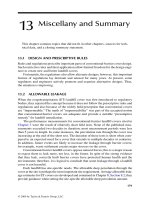DEFINITIONS CONVERSIONS and CALCULATIONS for OCCUPATIONAL SAFETY and HEALTH PROFESSIONALS - CHAPTER 1 ppt
Bạn đang xem bản rút gọn của tài liệu. Xem và tải ngay bản đầy đủ của tài liệu tại đây (1.17 MB, 87 trang )
© 1998 by CRC Press LLC.With Pride & Gratitude,
this work is dedicated to my family:
to my Wife, Gladys,
who deserves to be identified
as the book’s Co-Author;
and to my two Sons, Phillip and Ryan,
who, every day, make me proud to
be their Father.
© 1998 by CRC Press LLC.
Preface
This book is intended to serve several purposes:
1. To function as a ready Desk Reference for the Occupational Safety and Health Profes-
sional, the Industrial Hygienist, and/or the Environmental Engineer. Such an individ-
ual, in the normal development of his or her career, will likely have specialized in some
relatively specific sub-area of one of these overall disciplines. For such an individual,
there will likely be occasions when a professional or job related problem or situation
will arise, one that falls within the general domain of Occupational Safety and Health,
Industrial Hygiene, or the Environment, but is outside of this individual's area of prin-
cipal focus and competence, and is, therefore, not immediately familiar to him or her.
For such cases, this Reference Source will, hopefully, provide a simple path toward the
answer.
2. To function as a useful Reference Source, Study Guide, or refresher to any individual
who is preparing to take either the Core or the Comprehensive Examination for Certifi-
cation as an Industrial Hygienist, a Safety Professional, an Environmental Engineer, or
an Environmental Professional.
3. Finally, to assist Students who have embarked on a course of study in one of these
disciplines. As a fairly concise compilation of most the various important mathemati-
cal relationships and definitions that these Students will be called upon to utilize as
they progress in their profession, it is hoped that this group, too, may find this work to
be of some value.
This book, as a Reference Information Source and Example Problem Workbook, contains
virtually every Mathematical Relationship, Formula, Definition, and Conversion Factor
that any Professional in any of these overall disciplines will ever need or encounter. Every
effort has been made to be certain that the information and relationships in it reflect the very
best of the current thinking and technological understanding, as these concepts are currently
used in the field.
Each of the Problem Solutions in this book contains carefully prepared step-by-step proce-
dures that were followed in developing the requested answer. In addition, these Solutions
contain explanations of the reasons and factors that had to be considered and used in com-
pleting each step. The underlying goal in generating these very detailed Solutions was that
they would constitute a very complete road map that leads from the Problem Statement,
itself, all the way to its eventual Solution. It is hoped that the various Problems, most
having been developed out of the real life professional experiences of the Author and some
of his colleagues, will prove to be representative of the actual situations that a professional
in any of these fields might routinely encounter in the normal conduct of his or her profes-
sional life; because of this, it is hoped that they, too, will be of special value to both the
professional and the prospective professional, alike.
Two final comments for the individual who has chosen to follow, or check out, each spe-
cific mathematical step shown in any of the Problem Solutions.
1. Each result — as it is developed and presented in its final "boxed" format — will have
been adjusted so as to contain the correct number of significant digits.
2. In many of the Problem Solutions, there will, of necessity, be separate steps involving
calculations that develop "intermediate" results — as an example, please refer to Prob-
lem #3.12, from Page 3-27. In this problem there are four major, but separate, sub-
results that must be calculated [see the Solution on Pages 3-54 through 3-57] in order
to develop the final result that is asked for in the Problem Statement. In order, for the
Solution of this Problem, these four steps are described below [labeled i, ii, iii, & iv]:
i. Determination of the set of four mass-based concentration TLV Standards from
the set of four volumetric based TLV Standards that were provided in the Problem
Statement;
© 1998 by CRC Press LLC.
ii. Determination of the overall TLV
effective
for the entire four component mixture,
considered as a whole;
iii. Determination of the theoretical individual vapor phase concentrations [mass-
based] for each of the four components in this mixture — i.e., what these concen-
trations would have to be in order for the previously calculated overall mixture
TLV
effective
to apply to the vapor phase; and
iv. Finally, a determination of the four volume-based equivalent concentrations corre-
sponding to each of these calculated mass-based concentrations.
For every multi-step Solution, each of the "intermediate" results will also have been
reported in an appropriate number of significant digits; however, each subsequent calcu-
lation that makes use of any of these "intermediate" results will employ the "un-
rounded" number value that has been retained in the math coprocessor of the computer
or the calculator that is being used to perform the calculations.
Because of this, any individual who methodically checks every step of any Problem
Solution in this Text will almost certainly develop "intermediate" results that differ
numerically from those in this section. This will be true if the answers that he or she
obtains, in this overall stepwise process, were developed from the rounded, rather than
the unrounded, "intermediate" values. To understand this situation better, please con-
sider the following specific, in-depth example:
I would like to discuss two specific calculation steps that are presented in
the Solution to Problem #3.12 [Page 3-27], as shown on Pages 3-54 through 3-
57. The two steps are listed on Pages 3-55 & 3-56 — they involve the deter-
mination of the mass-based concentration of Methylene Chloride. This "in-
termediate" result was calculated to be 189.557+ mg/m
3
, and reported — in
its rounded form — as 190 mg/m
3
. In each subsequent calculation step in the
Solution to this Problem, the value of this concentration appears to have
been used in its rounded form; however, such was never the case. Its un-
rounded equivalent always remained in the math coprocessor (where it had
been carried out to a precision of many decimal places) and in every similar
case each such value was always this value — namely, 189.557+ mg/m
3
—
that was used in each subsequent calculation, rather than the indicated
rounded 190 mg/m
3
value.
To continue with this specific example, consider one of the expressions used
to calculate the TLV
effective
for the entire mixture. The expression to which I
refer is shown below:
TLV
.
,
.
,
.
,
.
effective
=
+++
1
025
6 175
055
8 361
015
2 084
005
190
The final term in the denominator of the overall expression for the TLV
effective
,
which is taken from the set of calculations referred to directly above, is
listed as:
005
190
.
If the individual who is carefully checking out each step of each solution car-
ries out this mathematical operation, using these values, on any calculator,
he or she will obtain as a result, 2 632 10. ×
–4
. Clearly, this differs slightly
from the listed value of 2 64 10. ×
–4
; however, the difference is certainly not
great. This latter value derives from using the ratio listed below, since it is
the unrounded 189.557+ mg/m
3
value that had been maintained in the calcu-
lator or computer that is being used. Thus the ratio actually employed in
making this math calculation was:
© 1998 by CRC Press LLC.
DEFINITIONS, CONVERSIONS, AND CALCULATIONS
005
189 557481931
.
. +
× = 2.6391145649 10
–4
It is this second ratio, in contrast to the first one, that produces the slightly
different 2 64 10. ×
–4
value listed above. Analogous slight deviations will
likely occur in every Problem Solution where there are any "intermediate"
numerical results, and the Reader should be aware of this possibility.
Should any reader wish to pass on comments or suggestions as to any aspect of the contents
of this volume, I can be reached at any of the following locations and/or listings:
High Tech Enterprises
P. O. Box 7835
Stockton, CA 95267-0835
Telephone: (209) 473-1113
Fax: (209) 473-1114
E-Mail:
Home Page:
Finally, I would like to compliment and thank any reader who has taken the trouble to wade
through all the foregoing commentary. I hope it will be helpful as you progress in your
studies or your career. Good luck as you put this volume into practical use.
Edward W. Finucane, PE, QEP, CSP, CIH
© 1998 by CRC Press LLC.
AUTHOR
Edward W. Finucane was born in San Francisco, and raised in Stockton, California. He
has earned degrees in Engineering from Stanford University, and in Business from Golden
Gate University. Professionally, Mr. Finucane has been involved in both the Environ-
mental and the Occupational Safety and Health fields for more than 30 years. During the
last eighteen, he has operated his own professional consulting company, High Tech Enter-
prises, out of offices in Stockton, California. Mr. Finucane is a Registered Professional
Engineer [PE], a Qualified Environmental Professional [QEP], a Certified Safety Profes-
sional [CSP], and a Certified Industrial Hygienist – Comprehensive Practice [CIH].
He has had extensive experience in the areas of: ambient gas analysis, gas analyzer calibra-
tion, indoor air quality, ventilation, noise and sound, heat and cold stress, health physics,
and in the general area of hazardous wastes.
For the past several years, he has served on the faculty of the twice yearly course, Compre-
hensive Review of Industrial Hygiene, offered jointly by the Center for Occupational and
Environmental Health [University of California at Berkeley, California] and the Northern
California Section of the American Industrial Hygiene Association.
Edward W. “Ted” Finucane’s E-Mail Address is: , and High Tech
Enterprises’ Home Page can be accessed at: .
© 1998 by CRC Press LLC.
ACKNOWLEDGMENTS
In authoring this text, I would like to thank a number of people without whose insights and
guidance this work would still not be complete. Included in this group are professional
associates, colleagues, friends, and even family members — in each case, individuals whose
perspectives and opinions were very important to me.
First, I would like to thank Kenneth P. McCombs, Acquisitions Editor, and his associate,
Susan Alfieri, Production Manager, both of whom work with my publisher, LEWIS PUB-
LISHERS/CRC PRESS, in New York City, NY. Their patience and understanding with
me and my very deliberate efforts to complete this work in a timely manner were remark-
able. In addition, Mimi Williams, Quality Assurance Editor — also with LEWIS PUB-
LISHERS/CRC PRESS, however, in their Boca Raton, FL, office — did an amazing job
of proofreading my manuscript. I was not able to disagree with anything she found to be
incorrect!
For sharing his significant experience in gas analyzer calibrations and standards, I would like
to thank Wayne A. Jalenak, Ph.D., of Maynard, MA. His comments and insights on the
material in the chapter covering Standards and Calibrations were invaluable.
For their contributions on the chapter covering Ionizing and Non-Ionizing Radiation, I
would like to thank my brother, James S. Finucane, Ph.D., of Bethesda, MD, and David
Baron, PE, of Minneapolis, MN. Jim’s help with the overall structure of this section and
Dave’s unique contributions in the area of non-ionizing radiation were, in each case, abso-
lutely vital to the development of the information in this chapter.
For sharing his expertise in the area of Statistics and Probability, I would like to acknowl-
edge the contributions of William R. Hill of Albuquerque, NM. Bill’s comments and sug-
gestions were vital in clarifying the various difficult relationships that are discussed in this
chapter.
David L. Williams of Santa Clara, CA, and Joel E. Johnson of Wilmington, DE, each pro-
vided their very valuable perspectives on the content of Appendix A, the section that covers
the Atmosphere.
For the knowledge and inspiration he provided me, I would like to acknowledge my teacher,
Professor Andrew J. Galambos, whose work in the physical and volitional sciences has pro-
vided me with the principal foundation upon which my own professional life has been
based.
Last, but most certainly not least, I would like to acknowledge and thank my wife, Gladys.
In spite of the fact that her formal education included neither the environment nor the area of
occupational safety and health, she proofread the entire text, and in doing so was able to
identify numerous areas where my descriptions required clarification, where I had omitted
important data, etc., etc. Needless to say, to the extent that the material in this book is
understandable to its readers, much of the credit must go to her.
© 1998 by CRC Press LLC.
Table of Contents
Chapter 1: The Basic Parameters and Laws of Physics & Chemistry
RELEVANT DEFINITIONS
Basic Units
Length
Mass
Time
Temperature
Electrical Current
The Amount of any Substance
Luminous Intensity
Supplemental Units
Plane Angle
Solid Angle
Derived Units
Area
Volume
Velocity or Speed
Acceleration
Force
Pressure
Energy, Work, or Heat
Power
Electric Charge
Electrical Potential or Potential Difference
Capacitance
Density
Concentration
Luminous Flux
Frequency
Radioactive Activity
Absorbed Radiation Dose
Radiation Dose Equivalent or Radiation Dose Equivalent Index
Atmospheric Standards
Standard Temperature and Pressure
Normal Temperature and Pressure
Ventilation-Based Standard Air
Metric Prefixes (for use with SI Units)
RELEVANT FORMULAE & RELATIONSHIPS
Temperature Conversions
Equation #1-1: Metric Temperature Conversion: Celsius (relative) to
Kelvin (absolute)
Equation #1-2: English Temperature Conversion: Fahrenheit (rela-
tive) to Rankine (absolute)
Equation #1-3: Relative Temperature Conversion: English System to
Metric System
Equation #1-4: Temperature Difference Conversion: Metric System to
English System
© 1998 by CRC Press LLC.
The Standard Gas Laws
Equation #1-5: Boyle’s Law
Equation #1-6: Charles’ Law
Equation #1-7: Gay-Lussac’s Law
Equation #1-8: General Gas Law
Equation #1-9: Ideal or Perfect Gas Law
The Mole
Equation #1-10: Mass Definition of the Mole
Equation #1-11: The Mole & Avogadro’s Number
Equation #1-12: Molar Volume @ STP
Equation #1-13: Molar Volume @ NTP
Other Gas Laws
Equation #1-14: The Gas Density Law
Equation #1-15: Dalton’s Law of Partial Pressures
Equation #1-16: Dalton’s Law of Partial Pressures Applied to the
Concentration of any Individual Volatile Solvent in an Overall
Vapor Mixture
Equation #1-17: Raoult’s Law, as Applied to Each Individual Com-
ponent in a Liquid Solution
Equation #1-18: Raoult’s Law, as Applied to the Entire Multi-
Component Liquid Solution
Equation #1-19: Definition of Absorbance
Settling Velocity of Various Types of Particulates Suspended
in Air
Equation #1-20: Stoke’s Law
Equation #1-21: Simplified Stoke’s Law
BASIC PARAMETERS AND LAWS OF PHYSICS & CHEM-
ISTRY PROBLEM SET
Problem #1.1: Application of Equation # 1-1
Problem #1.2: Application of Equation # 1-2
Problem #1.3: Application of Equation # 1-3
Problem #1.4: Application of Equation # 1-4
Problem #1.5: Application of Equation # 1-5
Problem #1.6: Application of Equation # 1-5
Problem #1.7: Application of Equation #s 1-1 & 1-6
Problem #1.8: Application of Equation #s 1-2 & 1-6
Problem #1.9: Application of Equation #s 1-1 & 1-7
Problem #1.10: Application of Equation #s 1-2 & 1-7
Problem #1.11: Application of Equation #s 1-2 & 1-8
Problem #1.12: Application of Equation #s 1-1 & 1-8
Problem #1.13: Application of Equation #s 1-1, 1-9, & 1-10
Problem #1.14: Application of Equation #s 1-1, 1-9, & 1-10
Problem #1.15: Application of Equation # 1-10
Problem #1.16: Application of Equation # 1-11
Problem #1.17: Application of Equation #s 1-10 & 1-12
Problem #1.18: Application of Equation # 1-10
Problem #1.19: Application of Equation #s 1-1 & 1-9
Problem #1.20: Application of Equation #s 1-2 & 1-14
Problem #1.21: Application of Equation #s 1-2 & 1-14
Problem #1.22: Application of Equation # 1-16
Problem #1.23: Application of Equation # 1-16
Problem #1.24: Application of Equation #s 1-10, 1-16, & 1-17
Problem #1.25: Application of Equation #s 1-10, 1-16, & 1-17
Problem #1.26: Application of Equation # 1-19
© 1998 by CRC Press LLC.
Problem #1.27: Application of Equation # 1-21
Problem #1.28: Application of Equation # 1-21
SOLUTIONS TO THE BASIC PARAMETERS AND LAWS
OF PHYSICS & CHEMISTRY PROBLEM SET— listed only
by the Problem Number
Problem #1.1
Problem #1.2
Problem #1.3
Problem #1.4
Problem #1.5
Problem #1.6
Problem #1.7
Problem #1.8
Problem #1.9
Problem #1.10
Problem #1.11
Problem #1.12
Problem #1.13
Problem #1.14
Problem #1.15
Problem #1.16
Problem #1.17
Problem #1.18
Problem #1.19
Problem #1.20
Problem #1.21
Problem #1.22
Problem #1.23
Problem #1.24
Problem #1.25
Problem #1.26
Problem #1.27
Problem #1.28
Chapter 2: Standards And Calibrations
RELEVANT DEFINITIONS
Primary Standard
Secondary Standard
Standard Reference Material
Calibration
Calibration Check
Sensitivity
Selectivity
Repeatability
Timeliness
Accuracy
Precision
RELEVANT FORMULAE & RELATIONSHIPS
Flow Rate & Flow Volume Calibrations
Equation #s 2-1 & 2-2: Rate to Volume Relationship
Gas Analyzer Calibrations & Calibration Checks
Equation #2-3: Volumetric Calibration Standard, using pure gas
sources — Low Concentration Levels (ppm)
© 1998 by CRC Press LLC.
Equation #2-4: Volumetric Calibration Standard, using pure gas
sources — High Concentration Levels (percent)
Equation #2-5: Volumetric Calibration Standard, using pure liquid
sources — Low Concentration Levels (ppm)
STANDARDS AND CALIBRATIONS PROBLEM SET
Problem #2.1: Application of Equation # 2-1
Problem #2.2: Application of Equation # 2-3
Problem #2.3: Application of Equation # 2-4
Problem #2.4: Application of Equation #s 1-1, 1-3, & 2-5
Problem #2.5: Application of Equation #s 1-1, 1-9, 1-10, 1-16, & 2-5
SOLUTIONS TO THE STANDARDS AND CALIBRATIONS
PROBLEM SET — listed only by the Problem Number
Problem #2.1
Problem #2.2
Problem #2.3
Problem #2.4
Problem #2.5
Chapter 3: Workplace Ambient Air
RELEVANT DEFINITIONS
Ambient Concentration Categories
Threshold Limit Values
Permissible Exposure Limits
Recommended Exposure Limits
Maximum Concentration Values in the Workplace
Time Weighted Averages
Short Term Exposure Limits
Ceiling Values
Action Levels
Excursion Limits
Designation of Immediately Dangerous to Life and/or Health
Breathing Zone
Ambient Dose-Response/Concentration-Response Parameters
Median Lethal Dose
Median Effective Dose
Median Lethal Concentration
“Other” Dose-Response, Concentration-Response Parameters
Parameters Relating to Specific Chemicals or Substances
Upper & Lower Explosive Limits
Explosive Range
Flash Point
Ambient Measurements of Concentration
“Volume-based” Concentrations
“Mass-based” Concentrations
Components & Measurement Parameters of the Ambient Air
Gas
Vapor
Aerodynamic Diameter
Aerosol
Dust
Mist
Smoke
© 1998 by CRC Press LLC.
Aspect Ratio
Fiber
RELEVANT FORMULAE & RELATIONSHIPS
Calculations Involving Time Weighted Averages [TWAs]
Equation #3-1: Basic Time Weighted Average Equation
Equation #3-2: Effective Percent Exposure Level Equation
Calculations Involving Exposure Limits
Equation #3-3: Effective TLV Exposure Limit Formula
Calculations Involving the Conversion of Concentration Units
Equation #3-4: Conversion of Mass-based Concentration Units to
their Volumetric Equivalents @ NTP
Equation #3-5: Conversion of Mass-based Concentration Units to
their Volumetric Equivalents @ STP
Equation #3-6: Conversion of Mass-based Concentration Units to
their Volumetric Equivalents under any Conditions
Equation #3-7: Conversion of Volume-based Concentration Units to
their Mass-based Equivalents @ NTP
Equation #3-8: Conversion of Volume-based Concentration Units to
their Mass-based Equivalents @ STP
Equation #3-9: Conversion of Volume-based Concentration Units to
their Mass-based Equivalents under any Conditions
Calculations Involving TLV Exposure Limits for Free Silica
Dusts in Ambient Air
Equation #3-10: TLV Equation for Respirable Quartz Dusts
Equation #3-11: TLV Equation for Total Silica Dusts
Equation #3-12: TLV Equation for the Three Most Common Types
of Silica Dusts
WORKPLACE AMBIENT AIR PROBLEM SET
Problem #3.1: Application of Equation # 3-1
Problem #3.2: Application of Equation # 3-1
Problem #3.3: Application of Equation # 3-1
Problem #3.4: Application of Equation # 3-1
Problem #3.5: Application of Equation # 3-1
Problem #3.6: Application of Equation # 3-1
Problem #3.7: Application of Equation # 3-1
Problem #3.8: Application of Equation # 3-1
Problem #3.9: Application of Equation # 3-1
Problem #3.10: Application of Equation # 3-2
Problem #3.11: Application of Equation # 3-2
Problem #3.12: Application of Equation #s 3-3, 3-5, & 3-8
Problem #3.13: Application of Equation #s 1-10, 1-16, 1-17, & 3-8
Problem #3.14: Application of Equation #s 3-3, 3-4, & 3-7
Problem #3.15: Application of Equation #s 1-10, 1-16, 1-17, & 3-7
Problem #3.16: Application of Equation #s 3-3, 3-4, & 3-7
Problem #3.17: Application of Equation # 3-1
Problem #3.18: Application of Equation #s 2-2 & 3-1
Problem #3.19: Application of Equation # 3-4
Problem #3.20: Application of Equation # 3-5
Problem #3.21: Application of Equation #s 1-1 & 3-6
Problem #3.22: Application of Equation # 3-7
Problem #3.23: Application of Equation # 3-8
Problem #3.24: Application of Equation #s 1-1 & 3-9
© 1998 by CRC Press LLC.
Fume
SOLUTIONS TO THE WORKPLACE AMBIENT AIR PROB-
LEM SET — listed only by the Problem Number
Problem #3.1
Problem #3.2
Problem #3.3
Problem #3.4
Problem #3.5
Problem #3.6
Problem #3.7
Problem #3.8
Problem #3.9
Problem #3.10
Problem #3.11
Problem #3.12
Problem #3.13
Problem #3.14
Problem #3.15
Problem #3.16
Problem #3.17
Problem #3.18
Problem #3.19
Problem #3.20
Problem #3.21
Problem #3.22
Problem #3.23
Problem #3.24
Problem #3.25
Problem #3.26
Chapter 4: Ventilation
RELEVANT DEFINITIONS
Ventilation Equipment & Basic Parameters
Hood
Flange
Capture Velocity
Slot Velocity
Face Velocity
Coefficient of Entry
Entry Loss
Duct
Blast Gate or Damper
Plenum
Flow Rate or Volumetric Flow Rate
Velocity or Duct Velocity
Air Handler or Blower or Fan
Air Horsepower
Brake Horsepower
Pressure Terms
Static Pressure
Velocity Pressure
Total Pressure
Manometer
© 1998 by CRC Press LLC.
Problem #3.26: Application of Equation # 3-12
Problem #3.25: Application of Equation # 3-10
Relative Humidity
Dew Point
Ventilation Standards
Ventilation Standard Air
RELEVANT FORMULAE & RELATIONSHIPS
Calculations Involving Gases Moving in Ducts
Equation #4-1: Volumetric Flow Rate Equation
Equation #4-2: Equation Relating Duct Velocity to the Velocity
Pressure & the Gas Density
Equation #4-3: Equation Relating Duct Velocity to the Velocity
Pressure
Equation #4-4: General Rule of Ventilation #1
Equation #4-5: General Rule of Ventilation #2
Equation #4-6: General Rule of Ventilation #3
Calculations Involving Hoods
Equation #4-7: Unflanged Hood Capture Velocity Equation
Equation #4-8: Flanged Hood Capture Velocity Equation
Equation #4-9: Simple Hood Formula
Equation #4-10: Hood Coefficient of Entry Equation
Equation #4-11: Hood Throat-Suction Equations
Equation #4-12: Hood Entry Loss Equation
Equation #4-13: Hood Entry Loss Factor Equation
Equation #s 4-14A, B, C, & D: Compound Hood Equations
Calculations Involving the Rotational Speeds of Fans
Equation #4-15: Air Discharge Volume Equation
Equation #4-16: Static Discharge Pressure Equation
Equation #4-17: Brake Horsepower Equation
Calculations Involving the Diameters of Fans
Equation #4-18: Air Discharge Volume Equation
Equation #4-19: Static Discharge Pressure Equation
Equation #4-20: Brake Horsepower Equation
Calculations Involving Various Other Fan-Related Factors
Equation #4-21: Fan Brake Horsepower Equation
Equation #4-22: Fan Total Pressure Equation
Equation #4-23: Fan Static Pressure Equation
Calculations Involving Air Flow Balancing at a Duct Junction
Equation #s 4-24 A & B: Duct Junction Balancing System
Calculations Involving Dilution Ventilation
Equation #4-25: Equilibrium Concentration Equation
Equation #4-26: Basic Room Purge Equation
Equation #4-27: Purge - Dilution Equation
VENTILATION PROBLEM SET
Problem #4.1: Application of Equation # 4-1
Problem #4.2: Application of Equation # 4-1
Problem #4.3: Application of Equation # 4-2
Problem #4.4: Application of Equation # 4-3
Problem #4.5: Application of Equation # 4-3
Problem #4.6: Application of Equation # 4-3
Problem #4.7: Application of Equation # 4-5
© 1998 by CRC Press LLC.
Absolute Humidity
Humidity Factors
Vapor Pressure
Problem #4.12: Application of Equation # 4-8
Problem #1.13: Application of Equation # 4-8
Problem #4.14: Application of Equation # 4-9
Problem #4.15: Application of Equation # 4-10
Problem #4.16: Application of Equation #s 4-5 & 4-9
Problem #4.17: Application of Equation # 4-10
Problem #4.18: Application of Equation # 4-11
Problem #4.19: Application of Equation # 4-1
Problem #4.20: Application of Equation # 4-3
Problem #4.21: Application of Equation #s 4-5 & 4-11
Problem #4.22: Application of Equation # 4-12
Problem #4.23: Application of Equation # 4-12
Problem #4.24: Application of Equation # 4-13
Problem #4.25: Application of Equation #s 4-3, 4-14A, 4-14C, &
4-14D
Problem #4.26: Application of Equation #s 4-3, 4-5, 4-14B, 4-14C,
& 4-14D
Problem #4.27: Application of Equation # 4-15
Problem #4.28: Application of Equation # 4-16
Problem #4.29: Application of Equation # 4-17
Problem #4-30: Application of Equation # 4-15
Problem #4.31: Application of Equation # 4-16
Problem #4.32: Application of Equation # 4-17
Problem #4.33: Application of Equation # 4-18
Problem #4.34: Application of Equation # 4-19
Problem #4.35: Application of Equation # 4-20
Problem #4.36: Application of Equation #s 4-1 & 4-18
Problem #4.37: Application of Equation #s 4-3, 4-5, & 4-19
Problem #4.38: Application of Equation # 4-20
Problem #4.39: Application of Equation #4-21
Problem #4.40 Application of Equation #s 4-1 & 4-21
Problem #4.41: Application of Equation #s 4-4, 4-5, 4-6, & 4-22
Problem #4.42: Application of Equation #s 4-5 & 4-22
Problem #4.43: Application of Equation #s 4-5 & 4-23
Problem #4.44: Application of Equation # 4-23
Problem #4.45: Application of Equation #s 4-24A & 4-24B
Problem #4.46: Application of Equation #s 1-1, 1-16, & 4-25
Problem #4.47: Application of Equation # 4-26
Problem #4.48: Application of Equation #s 1-1, 1-16, & 4-25
Problem #4.49: Application of Equation # 4-26
Problem #4.50: Application of Equation # 4-27
SOLUTIONS TO THE VENTILATION PROBLEM SET —
listed only by the Problem Number
Problem #4.1
Problem #4.2
Problem #4.3
Problem #4.4
Problem #4.5
Problem #4.6
Problem #4.7
Problem #4.8
© 1998 by CRC Press LLC.
Problem #4.11: Application of Equation # 4-7
Problem #4.10: Application of Equation # 4-6
Problem #4.9: Application of Equation # 4-6
Problem #4.8: Application of Equation # 4-5
Problem #4.13
Problem #4.14
Problem #4.15
Problem #4.16
Problem #4.17
Problem #4.18
Problem #4.19
Problem #4.20
Problem #4.21
Problem #4.22
Problem #4.23
Problem #4.24
Problem #4.25
Problem #4.26
Problem #4.27
Problem #4.28
Problem #4.29
Problem #4.30
Problem #4.31
Problem #4.32
Problem #4.33
Problem #4.34
Problem #4.35
Problem #4.36
Problem #4.37
Problem #4.38
Problem #4.39
Problem #4.40
Problem #4.41
Problem #4.42
Problem #4.43
Problem #4.44
Problem #4.45
Problem #4.46
Problem #4.47
Problem #4.48
Problem #4.49
Problem #4.50
Chapter 5: Thermal Stress
RELEVANT DEFINITIONS
Thermal Stress
Heat Stress
Heat Stress Disorders
Cold Stress
Cold Stress Disorders
Ambient Conditions Related to Thermal Stress
Dry Bulb Temperature
Wet Bulb Temperature
Air or Wind Speed
© 1998 by CRC Press LLC.
Problem #4.12
Problem #4.11
Problem #4.10
Problem #4.9
Thermal Stress (Indoor/Outdoor), With & Without Solar Load
Equation #5-1: Wet Bulb Globe Temperature Index Equation — No
Solar Load
Equation #5-2: Wet Bulb Globe Temperature Index Equation — With
Solar Load
Temperature Related Time Weighted Averages
Equation #5-3: Time Weighted Average WBGT Index
THERMAL STRESS PROBLEM SET
Problem #5.1: Application of Equation #s 1-3 & 5-2
Problem #5.2: Application of Equation #s 1-3 & 5-1
Problem #5.3: Application of Equation #s 1-3, 5-1, & 5-3
Problem #5.4: Application of Equation #s 1-10 & 5-3
SOLUTIONS TO THE THERMAL STRESS PROBLEM SET
— listed only by the Problem Number
Problem #5.1
Problem #5.2
Problem #5.3
Problem #5.4
Chapter 6: Sound and Noise
RELEVANT DEFINITIONS
Categories of Noise
Continuous Noise
Intermittent Noise
Characteristics of Sounds and/or Noise
Frequency
Frequency Band
Octave Bands & Bandwidths
Sound Wavelength
Pitch
Velocity of Sound
Loudness
Characteristic Parameters of Sound and Noise
Sound Intensity & Sound Intensity Level
Sound Power & Sound Power Level
Sound Pressure
Root-Mean-Square [RMS] Sound Pressure
Common Measurements of Sound Levels
Sound Pressure Level
Threshold of Hearing
Threshold of Pain
Sound and/or Noise Measurement Time Weightings
Peak Noise
Impulsive or Impact Noise
Fast Time Weighted Noise
Slow Time Weighted Noise
© 1998 by CRC Press LLC.
RELEVANT FORMULAE & RELATIONSHIPS
Wet Bulb Globe Temperature Index
Effective Temperature
Globe Temperature
Sound and/or Noise Measurement Frequency Weightings
Linear Frequency Weighting
A-Frequency Weighting Scale
B-Frequency Weighting Scale
C-Frequency Weighting Scale
RELEVANT FORMULAE & RELATIONSHIPS
Approximate Velocity of Sound in Air
Equation #6-1: Approximate Velocity of Sound in Air
Basic Sound Measurements — Definitions
Equation #6-2: Sound Pressure Level Equation
Equation #6-3: Sound Intensity Level Equation
Equation #6-4: Sound Power Level Equation
Sound Pressure Levels of Noise Sources in a Free Field
Equation #6-5: Effective Sound Pressure Level of a Noise Source in a
Free Field
Addition of Sound Pressure Levels from Several Independent
Sources
Equation #6-6: Addition of Several Independent Sound Pressure Lev-
els
Calculations Involving Sound Pressure Level “Doses”
Equation #6-7: Maximum Time Period at Any Equivalent Sound
Pressure Level
Equation #6-8: Effective Daily Dose
Equation #6-9: Equivalent Sound Pressure Level at Any Daily Dose
Definitions of the Three Common Frequency Weighting
Scales
Equation #6-10: Definitions of the “A”, “B”, & “C” Weighting
Scales
Various Octave Band Relationships
Equation #6-11: Full Octave Bands — Upper & Lower Band-Edge
Frequencies
Equation #6-12: Full Octave Bands — Center Frequency
Equation #6-13: Half Octave Bands — Upper & Lower Band-Edge
Frequencies
Equation #6-14: Half Octave Bands — Center Frequency
Equation #6-15: 1/ n
th
Octave Bands — Upper & Lower Band-Edge
Frequencies
Equation #6-16: 1/ n
th
Octave Bands — Center Frequency
SOUND & NOISE PROBLEM SET
Problem #6.1: Application of Equation # 6-1
Problem #6.2: Application of Equation #s 1-3 & 6-1
Problem #6.3: Application of Equation # 6-2
Problem #6.4: Application of Equation # 6-3
Problem #6.5: Application of Equation # 6-4
Problem #6.6: Application of Equation # 6-5
Problem #6.7: Application of Equation # 6-5
Problem #6.8: Application of Equation # 6-6
Problem #6.9: Application of Equation # 6-6
Problem #6.10: Application of Equation # 6-7
Problem #6.11: Application of Equation # 6-7
Problem #6.12: Application of Equation #s 6-7 & 6-8
Problem #6.13: Application of Equation # 6-9
Problem #6.14: Application of Equation #s 6-7 & 6-8
© 1998 by CRC Press LLC.
Problem #6.15: Application of Equation # 6-9
Problem #6.16: Application of Equation # 6-10
Problem #6.17: Application of Equation #s 6-10, 6-11, & 6-12
Problem #6.18: Application of Equation #s 6-11 & 6-12
Problem #6.19: Application of Equation #s 6-13 & 6-14
Problem #6.20: Application of Equation #s 6-15 & 6-16
SOLUTIONS TO THE SOUND & NOISE PROBLEM SET —
listed only by the Problem Number
Problem #6.1
Problem #6.2
Problem #6.3
Problem #6.4
Problem #6.5
Problem #6.6
Problem #6.7
Problem #6.8
Problem #6.9
Problem #6.10
Problem #6.11
Problem #6.12
Problem #6.13
Problem #6.14
Problem #6.15
Problem #6.16
Problem #6.17
Problem #6.18
Problem #6.19
Problem #6.20
Chapter 7: Ionizing & Non-ionizing Radiation
RELEVANT DEFINITIONS
Electromagnetic Radiation
Electromagnetic Radiation
Ionizing Radiation
Categories of Ionizing Radiation
Cosmic Radiation
Nuclear Radiation
Gamma Radiation
Alpha Radiation
Beta Radiation
Neutron Radiation
X-Radiation
Ultraviolet Radiation
Categories of Non-Ionizing Radiation
Visible Light
Infrared Radiation
Microwave Radiation
Radio Frequency Radiation
Sub-Radio Frequency Radiation
Radiation Characteristics vs. Field Characteristics
Sources of Ionizing Radiation
Radioactivity
Radioactive Decay
© 1998 by CRC Press LLC.
Radioactive Decay Constant
Mean Life
Half-Life
Nuclear Fission
Radiation Measurements
Strength or Activity of a Radioactive Source
Exposure
Dose
Dose Equivalent
RELEVANT FORMULAE & RELATIONSHIPS
Basic Relationships for Electromagnetic Radiation
Equation #7-1: Basic Relationship Between Wavelength, Frequency,
& the Speed of Light
Equation #7-2: Basic Relationship Between Wavelength & Wave-
number
Equation #7-3: Planck’s Law
Calculations Involving Radioactive Decay
Equation #7-4: Basic Exponential Decay Law as Applied to Radioac-
tive Decay
Equation #7-5: Basic Relationship Between the Half-Life and the Ra-
dioactive Decay Constant
Equation #7-6: Mean Life Equation
Equation #7-7: Source Activity, in Becquerels
Equation #7-8: Source Activity in Curies
Equation #7-9: Basic Relationship Between Activity and the
Radioactive Decay Constant
Equation #7-10: Basic Relationship Between Activity and the
Half-Life
Dose and/or Exposure Calculations
Equation #7-11: X-Ray Dose Exposure Rates
Equation #7-12: Absorbed Radiation Dose vs. Dose Equivalent Rela-
tionship
Calculations Involving the Reduction of Radiation Intensity
Levels
Equation #7-13: Half Thickness Equation
Equation #7-14: Inverse Square Law
Calculations Involving Optical Densities
Equation #7-15: Optical Density Formula
Relationships Involving Microwaves
Equation #7-16: Distance to the Far Field
Equation #7-17: Near Field Microwave Power Density Equation
Equation #7-18: Far Field Microwave Power Density Equation
Equation #7-19: Distance to the Far Field
IONIZING AND NON-IONIZING RADIATION PROBLEM
SET
Problem #7.1: Application of Equation # 7-1
Problem #7.2: Application of Equation # 7-3
Problem #7.3: Application of Equation #s 7-1 or 7-2
Problem #7.4: Application of Equation # 7-1
Problem #7.5: Application of Equation #s 7-1 or 7-2
Problem #7.6: Application of Equation # 7-3
Problem #7.7: Application of Equation #s 7-1 & 7-3
Problem #7.8: Application of Equation # 7-4
© 1998 by CRC Press LLC.
Problem #7.9: Application of Equation #s 7-5 & 7-6
Problem #7.10: Application of Equation #s 1-10, 1-11, 7-7, & 7-9
Problem #7.11: Application of Equation # 7-4
Problem #7.12: Application of Equation # 7-5
Problem #7.13: Application of Equation # 7-5
Problem #7.14: Application of Equation # 7-10
Problem #7.15: Application of Equation #s 7-4 & 7-5
Problem #7.16: Application of Equation # 7-11
Problem #7.17: Application of Equation # 7-11
Problem #7.18: Application of Equation # 7-12
Problem #7.19: Application of Equation # 7-12
Problem #7.20: Application of Equation # 7-13
Problem #7.21: Application of Equation # 7-14
Problem #7.22: Application of Equation # 7-14
Problem #7.23: Application of Equation # 7-15
Problem #7.24: Application of Equation # 7-15
Problem #7.25: Application of Equation # 7-16
Problem #7.26: Application of Equation #s 3-1 & 7-17
Problem #7.27: Application of Equation # 7-19
Problem #7.28: Application of Equation # 7-18
Problem #7.29 Application of Equation #s 7-1 & 7-16
Problem #7.30: Application of Equation #s 7-1 & 7-18
SOLUTIONS TO THE IONIZING AND NON-IONIZING
RADIATION PROBLEM SET — listed only by the Problem
Number
Problem #7.1
Problem #7.2
Problem #7.3
Problem #7.4
Problem #7.5
Problem #7.6
Problem #7.7
Problem #7.8
Problem #7.9
Problem #7.10
Problem #7.11
Problem #7.12
Problem #7.13
Problem #7.14
Problem #7.15
Problem #7.16
Problem #7.17
Problem #7.18
Problem #7.19
Problem #7.20
Problem #7.21
Problem #7.22
Problem #7.23
Problem #7.24
Problem #7.25
Problem #7.26
Problem #7.27
Problem #7.28
Problem #7.29
Problem #7.30
© 1998 by CRC Press LLC.
Chapter 8: Statistics and Probability
RELEVANT DEFINITIONS
Populations
Distributions
Specific Types of Distributions
Uniform Distribution
Normal Distribution
Binomial Distribution
Exponential Distribution
Characteristics of Populations and/or Distributions
Member
Variable
Sample
Parameter
Sample Statistic
Parameters of Populations and/or Distributions
Frequency Distribution
Range
Mean
Geometric Mean
Median
Mode
Sample Variance
Sample Standard Deviation
Sample Coefficient of Variation / Relative Standard Deviation
Population Variance
Population Standard Deviation
Population Coefficient of Variation
Probability Factors and Terms
Experiment
Result
Sample Space
Event
Compound Event
Complementary Event
Probabilities Associated with Results
Probability of the Occurrence of Any Type of Event
RELEVANT FORMULAE & RELATIONSHIPS
Parameters Relating to Any Population or Distribution
Equation #8-1: Range Equation
Equation #8-2: Magnitude of the Range
Equation #8-3: Mean Equation
Equation #8-4: Geometric Mean Equation
Equation #8-5: Median Relationship
Equation #8-6: Mode Relationship
Equation #8-7: Sample Variance Equation
Equation #8-8: Population Variance Equation
Equation #8-9: Sample Standard Deviation Equation
Equation #8-10: Population Standard Deviation Equation
Equation #8-11: Sample Coefficient of Variation Equation
Equation #8-12: Population Coefficient of Variation Equation
© 1998 by CRC Press LLC.
STATISTICS AND PROBABILITY PROBLEM SET
Problem #8.1: Application of Equation # 8-1
Problem #8.2: Application of Equation # 8-3
Problem #8.3: Application of Equation #s 8-2 & 8-4
Problem #8.4: Application of Equation # 8-5
Problem #8.5: Application of Equation # 8-6
Problem #8.6: Application of Equation # 8-7
Problem #8.7: Application of Equation # 8-9
Problem #8.8: Application of Equation # 8-11
Problem #8.9: Application of Equation # 8-8
Problem #8.10: Application of Equation # 8-10
Problem #8.11: Application of Equation # 8-12
Problem #8.12: Application of Probability Computations
Problem #8.13: Application of Probability Computations
Problem #8.14: Application of Probability Computations
Problem #8.15: Application of Probability Computations
Problem #8.16: Application of Probability Computations
Problem #8.17: Application of Probability Computations
SOLUTIONS TO THE STATISTICS AND PROBABILITY
PROBLEM SET — listed only by the Problem Number
Problem #8.1
Problem #8.2
Problem #8.3
Problem #8.4
Problem #8.5
Problem #8.6
Problem #8.7
Problem #8.8
Problem #8.9
Problem #8.10
Problem #8.11
Problem #8.12
Problem #8.13
Problem #8.14
Problem #8.15
Problem #8.16
Problem #8.17
© 1998 by CRC Press LLC.
